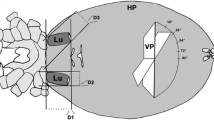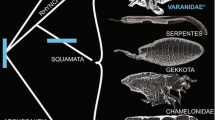Summary
The structure, dimensions and gas exchanging properties of the lungs of the Australian Carpet PythonMorelia spilotes variegata have been studied by dissection, by sampling lung gas and pulmonary venous blood and by using radioactive techniques to monitor distribution of ventilation (\(\dot V\)) and blood flow (\(\dot Q\)). The lungs have alveolar and saccular parts (mean capacities 10.2 and 129.3 ml/kg body weight, respectively). The sacs store inspired air creating a “flow through” situation which abolishes the dead space effect, prevents large expansions of the alveolar lung and allows gas exchange during both inspiration and expiration. Gas exchange was measured in intubated snakes in the resting and active states at 20–26 °C. In the resting state, respiratory frequency, tidal volume and ventilation were 1.72±0.56/min, 14.8±10.8 ml/kg, 22.04±7.75 ml/kg · min and pulmonary venousP O 2,P CO 2 and pH were 58.9±14.5 Torr, 21.5±4.2 Torr, and 7.55±0.07 Torr, respectively. R. Q. was low, 0.65±0.11. In the active state both ventilation (\(\dot V\)) and cardiac output increase and blood flow is redistributed more evenly along the alveolar lung, enabling increased O2 uptake. Since blood flow (\(\dot Q\)) in the alveolar lung is stratified (Read and Donnelly, 1972) redistribution of\(\dot Q\) during activity is proposed as a possible reserve capacity for O2 extraction by reptilian lungs.
Similar content being viewed by others
References
Bellairs, A.: The life of reptiles. Vol. I, 242 pp. London: Weiderfeld and Nicolson 1969
Benedict, F. G.: The physiology of large reptiles with special reference to the heat production of snakes, tortoises, lizards and alligators. Carnegie Institution of Washington, Publ. No. 425 (1932)
Bennett, A. F.: Ventilation in two species of lizards during rest and activity. Comp. Biochem. Physiol.49A, 653–671 (1973)
Boyd, R. E., Ackerman, S. A., Morris, J. G., Huberty, J. P.: Lung scanning using 99m Tc-labelled macroaggregated ferrous hydroxide (Tc-MAFH) as the perfusion agent. J. nucl. Med.10, 737–739 (1969)
Brattstrom, B. H.: The function of the air sac in snakes. Herpetologica15, 103–104 (1959)
Coulsen, R. A., Hernandez, T.: Biochemistry of the alligator: a study of metabolism in slow motion. 106 pp. Baton Rouge: Louisiana State Univ. Press 1964
Flanigan, W. F., Jr., Knight, C. P., Hartse, K. M., Rechtschaffen, A.: Sleep and wakefulness in chelonian reptiles. I. The box turtle (Terrapene carolina). Arch. ital. Biol.112, 227–252 (1974)
Gatz, R. N., Fedde, M. R., Crawford, E. C., Jr.: Lizard lungs: CO2-sensitive receptors inTupinambis nigropunctatus. Experientia31, 455–456 (1975)
George, J. C., Shah, R. V.: Evolution of air sacs in Sauropsida. J. Anim. Morph. Physiol.12, 255–263 (1965)
Graham, J. B.: Aquatic respiration in the sea snakePelamis platurus. Respir. Physiol.21, 1–7 (1974)
Greenwald, O. E.: The effect of body temperature on oxygen consumption and heart rate in the Sonora Gopher snakePituophis catehifer affines (Hallowell). Copeia1971, 98–106 (1971)
Hance, H. E.: Water snake respiration. Bull. Phil. Herp. Soc.20, 3–13 (1972)
Hartline, P. H.: Physiological basis for detection of sound and vibration in snakes. J. exp. Biol.54, 349–371 (1971)
Karlstrom, E. L.: Functional anatomy of the respiratory systems ofNatrix taxispilota andThamnophis o. ordinatus. Masters Thesis, Univ. Washington, Seattle (1952)
Leuth, F. X.: Effects of temperature on snakes. Copeia3, 125–132 (1941)
McDonald, H. S.: Respiratory functions of the ophidian air sac. Herpetologica15, 193–198 (1959)
Meneely, G. R., Kaltreider, N. L.: The volume of the lung determined by helium dilution. J. clin. Invest.28, 129–139 (1949)
Neifeh, K. H., Huggins, S. E., Hoff, H. E., Hugg, T. W., Norton, R. E.: Respiratory patterns of crocodilian reptiles. Respir. Physiol.9, 31–42 (1970)
Nielsen, B.: On the regulation in reptiles. II. The effects of hypoxia with and without moderate hypercapnia on the respiration and metabolism of lizards. J. exp. Biol.39, 107–117 (1962)
Peyrethon, J., Dusan-Peyrethon, D.: Etude polygraphique du cycle veille-sommeil chez trois genres de reptiles. C. R. soc. Biol. (Paris)163, 181–186 (1969)
Randall, W. C., Stullken, D. E., Hiestand, W. A.: Respiration of reptiles as influenced by the composition of the inspired air. Copeia3, 136–144 (1944)
Read, J., Donnelly, P.: Stratification of blood flow in the elongated lungs of the carpet python. J. appl. Physiol.32, 842–846 (1972)
Rosenberg, H. J.: Functional anatomy of pulmonary ventilation in the Garter Snake,Thamnophis elegans 1. J. Morphol.140, 171–184 (1973)
Roth, L. W.: The effect of hypophysectomy upon the respiratory quotient of snakes. Physiol. Zool.15, 224–233 (1942)
Saalfeld, E. F. von: Die Mechanik der Atmung beiUromastix (Lacertilia). Pflügers Arch. ges. Physiol.233, 431 (1934)
Seymour, R. S.: How sea snakes may avoid the bends. Nature250, 489–490 (1974)
Standaert, T., Johansen, K.: Cutaneous gas exchange in snakes. J. comp. Physiol.89, 313–320 (1974)
Varde, M. R.: The morphology and histology of the lung in snakes. J. Univ. Bombay B19, 79–89 (1951)
Vinegar, A., Hutchison, V. H., Dowling, H. G.: Metabolism, energetics, and thermoregulation during brooding of snakes of the genusPython (Reptilia, Boidae). Zoologica (N. Y. Zoological Society)55, 19–48 (1970)
Wolf, S.: Zur Kenntnis von Bau und Funktion der Reptilienlungen. Zool. Jb. Abt. Anat. Ont.57, 139–190 (1933)
Worrell, E.: Reptiles of Australia. Sydney: Angus and Robertson 1963
Author information
Authors and Affiliations
Rights and permissions
About this article
Cite this article
Donnelly, P., Woolcock, A.J. Ventilation and gas exchange in the Carpet Python,Morelia spilotes variegata . J Comp Physiol B 122, 403–418 (1977). https://doi.org/10.1007/BF00692525
Received:
Issue Date:
DOI: https://doi.org/10.1007/BF00692525




